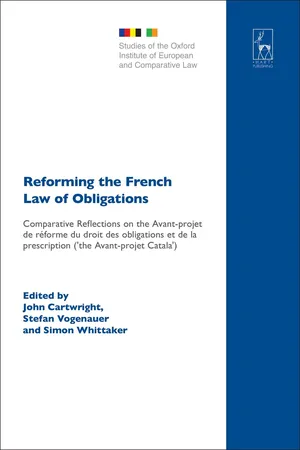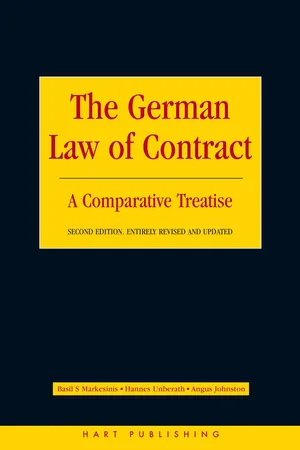Law
Fault in Contract law
In contract law, a fault refers to a breach of the terms and conditions agreed upon in a contract. It can occur when one party fails to fulfill their obligations, leading to legal consequences. Fault can be categorized as either a material breach, which goes to the core of the contract, or a minor breach, which is less significant and may not warrant legal action.
Written by Perlego with AI-assistance
Related key terms
1 of 5
3 Key excerpts on "Fault in Contract law"
- eBook - PDF
Reforming the French Law of Obligations
Comparative Reflections on the Avant-projet de réforme du droit des obligations et de la prescription ('the Avant-projet Catala')
- John Cartwright, Stefan Vogenauer, Simon Whittaker, John Cartwright, Stefan Vogenauer, Simon Whittaker(Authors)
- 2009(Publication Date)
- Hart Publishing(Publisher)
12 The Definition of la faute in the Avant-projet de réforme JEAN-SÉBASTIEN BORGHETTI F AULT IS ONE of those concepts that jurists find particularly diffi-cult to define because they are not exclusively legal notions: legal or juridical fault is just one type of fault among many others and co-exists with moral fault, political fault, fault in a sporting context, etc. All these particular types of fault are often seen as various instances of a single overarching category. It is true that the basis for such an essentialist posi-tion which would postulate the existence of an absolute concept of fault without any qualification or modification is debatable. Nevertheless, it is clear that the word ‘fault’ forms a part of everyday language and that, as such, it has a significance which is not primarily juridical. Fault is certainly not the only term borrowed from everyday language which is employed to designate a legal concept. The law of civil liability is indeed very rich—though no more so than the other branches of the law— in these ambiguous concepts which first have significance for the generality of human beings before they identify a particular legal concept: harm, causation or indeed defectiveness are further examples, along with fault. It is inevitable as well as desirable that the law should borrow from everyday language some, indeed the majority, of the terms that it uses. That expresses the link between law and the reality for which it is called to provide structure, reinforcement and direction—a link which should be unbreakable. These concepts, which are in a certain sense at the crossroads between everyday language and legal language, nevertheless create particular diffi-culties in terms of their definition. Their legal meaning must be clearly distinguished from their ordinary meaning. - eBook - PDF
Law and Economics
An Introductory Analysis
- Werner Z. Hirsch(Author)
- 2014(Publication Date)
- Academic Press(Publisher)
5 CONTRACT LAW INTRODUCTION Contract law has developed over the centuries as a means of facilitating economic exchanges. By providing guidelines for transactions other than those involving real property, it helps increase the wealth of the nation. To facilitate the assessment of contract law, its basic legal premises are first presented. After the nature of a contract is defined and related to the notion of consideration, a number of formation defenses are ex-plored. Thereafter, performance defenses, the notion of anticipatory repudiation, and damages rules are explored. After setting forth the legal principles of contract law, I examine some of its economic aspects. The economic framework used allows the posi-tions of the buyer and the seller in general, within credit transactions in particular, to be evaluated. The focus is on transaction costs in the for-mation and performance stages, and on evaluation of different contract clauses. The unconscionability of certain contract clauses and contract terms are also examined within this framework. THE BASIC LEGAL PREMISES OF CONTRACT LAW WHAT IS A CONTRACT? A contract is a promissory agreement for a future exchange, freely and voluntarily arrived at. The law of contracts is designed to facilitate the 129 130 5 CONTRACT LAW process of exchange and to minimize breakdowns, and thus it contrib-utes to transaction efficiencies. Within a system of contract remedies, incentives are provided to make good on promises. If the parties to the bargain agree, the law terms the agreement a contract, and for certain types of agreements society provides legal enforcement remedies should one of the parties decide to breach the contract. Contracts as a societal institution facilitate efficient exchange by providing a social mechanism for enforcing those agreements where aggregate value between the par-ties can be presumed to have increased. But not all promissory ex-changes in society are enforceable as contracts. - eBook - PDF
The German Law of Contract
A Comparative Treatise
- Basil S Markesinis, Hannes Unberath, Angus C Johnston(Authors)
- 2006(Publication Date)
- Hart Publishing(Publisher)
Those areas of English law that are fault-based have both statutory (eg, section 13 of the Supply of Goods and Services Act 1982, where the service provider undertakes to ‘carry out the service with reasonable care and skill’ when he does this in the course of a business) and common law foundations. Many contracts for the supply of services alone are treated as impos- ing only duties of care on the supplier: typically, these are situations where no guaran- tee is offered as to the result or outcome—eg, the provision of legal services in the conduct of litigation or medical services (on the latter, see Thake v Maurice [1986] QB 644, where tort liability was made out for failure to warn that the operation might not effect permanent sterility, but no guarantee as to the success of the operation was held to have been made). (Compare, however, the position of architects where errors of design are made, where the courts have been prepared to hold that the design amounted to a guarantee that the resulting building would be suitable for the client’s needs: Greaves & Co (Contractors) Ltd v Baynham Meikle & Partners [1975] 1 WLR 1095 (especially at 1101); and see generally, Treitel, The Law of Contract, pp 840–2.) (iii) Alleviating the Standard of Care Up to this point, we have examined instances in which the standard of care was simi- lar to what one would expect from a ‘guarantee’-type of liability. It remains to be 450 BREACH OF CONTRACT: GENERAL PRINCIPLES observed that German law also provides for a standard of care that is even less strict than § 276 I BGB (intention and negligence). Sometimes the debtor is responsible only for a qualified ‘fault’. This situation arises in three different lines of cases.
Index pages curate the most relevant extracts from our library of academic textbooks. They’ve been created using an in-house natural language model (NLM), each adding context and meaning to key research topics.


